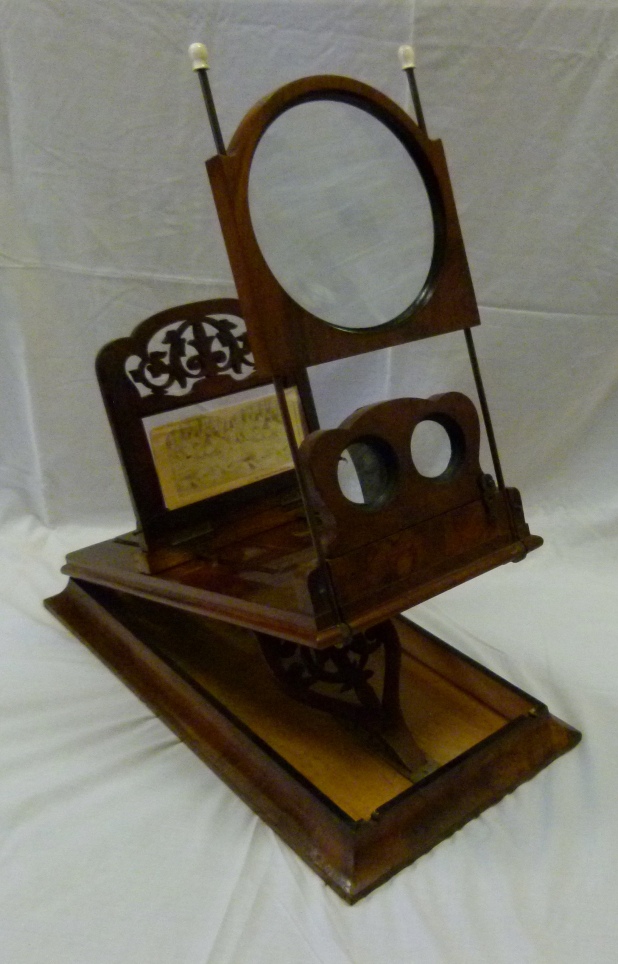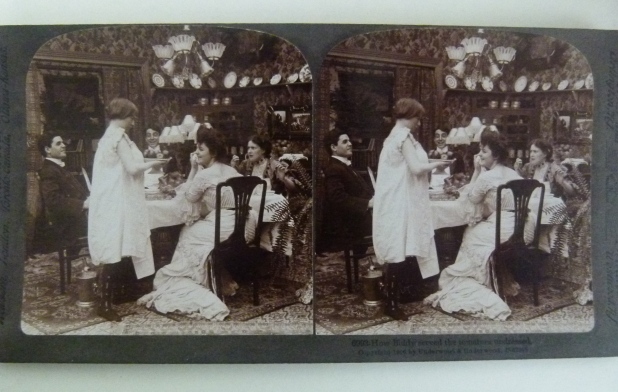The objects of the week could be seen as the 18oos version of 3D movies at IMAX theatres. Stereoscopes and the accompanying stereographs (stereo view + photographs) were used for entertainment and educational purposes from the 1830’s until the 1920s.
When you look at the objects featured in this post you really do wonder about what the residents of Moruya thought when they first looked at stereographic images of Rome, Paris and Japan through these stereoscopes, Did they marvel at the famous images of the Columbian Exposition held in Chicago in 1893? How many residents in the very early years of Federation were interested in the images of the ‘foreign’ Russo-Japanese War in 1904?

Description: In the MDHS collection we have a large table top, collapsible stereoscopic viewer made of wood with a finish in a birds-eye veneer. The viewer has three components: the base ( 15 x 30 cms) , the viewer and the easel. The viewer has a set of lenses which can be focused. Immediately behind them is a box construction which folds open when using the viewer for normal size stereoscopic cards. Above the lens is a large fixed lens used for viewing large single prints. On the easel is a shelf for large single and large stereoscopic viewers. The easel can be moved vertically and horizontally.
Markings: The engraved label: ANCne Mon MARTINET, A. HAUTECCEUR, 172, RUE DE RIVOLI
Stamped on the hinged wooden foot is: BREVETE, SDGD (“Brevete San Garantie Du Governement”) – meaning “Patent without the Government guarantee”. This places the artefact as being first patented in the 1860s.
History Of stereoscopes: The idea for stereoview photographs (also known as stereoscopic photographs, stereographs, or, simply, views) was hatched long before their invention, and even well prior to the first photographs. In the early 17th century, three separate men, Giovanni Battista della Porta, Jacopo Chimenti da Empoli, and Francois d’Aguillion, made drawings, or allusions to, what would eventually become the stereoscope or stereo viewer.
What these men envisioned essentially became a reality when the stereoscope was finally introduced in the early 19th century. Stereoscopes use two nearly-identical images, each taken a few inches to the side of the other. When viewed through two lenses set 2.5 inches apart, approximately the space between the eyes, the result is the illusion of a three-dimensional picture. In fact, stereoscopes are seen as the precursors to 3D entertainment. Much of the three-dimensional technology of today is based on the simple principles that allow the stereoscope to function.

The first stereoscope was introduced in 1833 by Sir Charles Wheatstone in Great Britain. At that time, photographs did not exist, so drawings were used instead. By the 1850s, photography was possible so stereoscopes began featuring this new technology.
Because the stereoscope preceded the publication of photographs in newspapers and magazines, stereo viewers were seen as forms of entertainment. People would pass around the stereoscope and see all sorts of beautiful scenes that they otherwise might never have been introduced to.




The use of stereoscopes and stereographs allowed people to see images of major current events. This was particularly important as newspapers of the time had very few or no images to support the text. In many series of stereographs designed to inform or instruct, detailed information could be found in the obverse of the view.


The Columbian Exposition (World Fair), held in Chicago in 1893 was one of the first world events photographed for a world market. Most of these images made their way around the world as stereographs. MDHS has one of these Columbian Exposition sets by Kilburn Bros in its collection.



Of course, a number of stereographs were designed to amuse and entertain.


In 1859 Oliver Wendell Holmes invented a handheld stereograph viewer which was later manufactured by Joseph L. Bates in Massachusetts. As Holmes didn’t patent this invention the vast majority of later stereoscopes were based on his design.
The stereoscope used by students of Newstead Public School, South Head, Moruya is a good example of this type of stereoscope.

The stereograms from Newstead PS were used mainly to teach children Social Studies . The images would have been used in Social Studies ( now History and Geography) lessons to help teach students about Australia and the world.
……(the stereographs proved a most effective adjunct to teaching, especially in the public schools for it is a well known fact that a more lasting impression is made through the eye than through the ear. About two-thirds of the product of the company’s stereoscopic and lantern slide department was exported to foreign countries. Until the great World War broke out in Europe, the company had a voluminous business with those goods.
Elmer Underwood 1924



And some stereographs are just interesting!




Leave a Reply